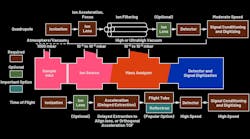Enhance ToF Mass Spectrometry with Low-Noise, High-Speed ADCs (Download)
Mass spectrometry (MS) is an analytical technique for quantifying known/unknown molecules within a sample based on molecular weight. By ionizing elements and/or molecules in the sample into gaseous ions with or without fragmentation, and then separating them in a mass analyzer, they are characterized by their mass-to-charge ratio (m/z), or location of the pulses, and relative abundance (or the amplitudes of the pulses) in the mass spectra.
A mass spectrometer consists of three major components: the ion source for producing gaseous ions from the sample under test, the mass analyzer for separating ions according to their m/z ratios, and the ion detector for detecting the ions and the relative abundance of each ion species. The detector output is conditioned and digitized to produce a mass spectrum. Several mass analyzers with fundamentally different strategies for separating ions of different m/z values are available.1 Figure 1 shows major blocks of quadrupole and time-of-flight (ToF) MS.
